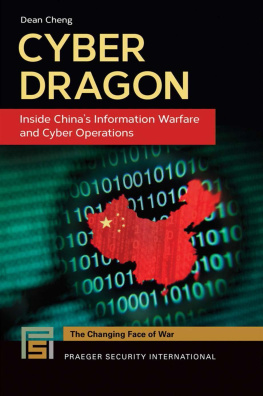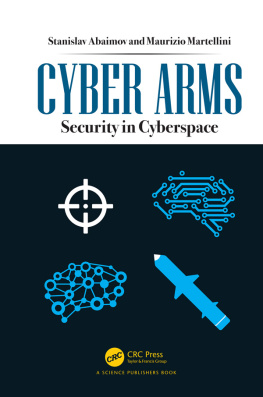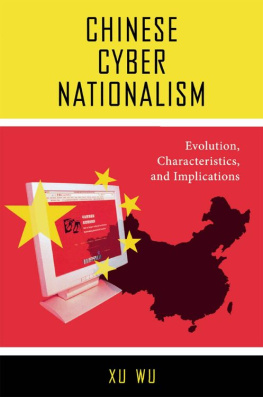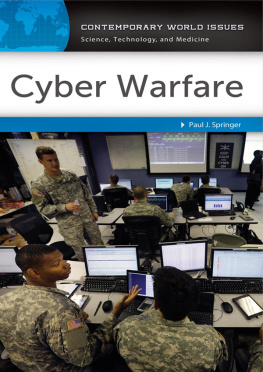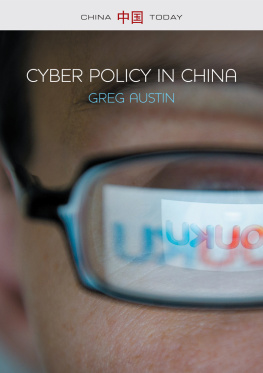Copyright
Copyright 2017 by Dean Cheng
All rights reserved. No part of this publication may be reproduced, stored in a retrieval system, or transmitted, in any form or by any means, electronic, mechanical, photocopying, recording, or otherwise, except for the inclusion of brief quotations in a review, without prior permission in writing from the publisher.
Library of Congress Cataloging-in-Publication Data
Names: Cheng, Dean (Writer on national security) author.
Title: Cyber dragon : inside Chinas information warfare and cyber operations / Dean Cheng.
Other titles: Inside Chinas information warfare and cyber operations
Description: Santa Barbara, California : Praeger, an imprint of ABC-CLIO, LLC, [2017] | Series: Changing face of war | Includes bibliographical references and index.
Identifiers: LCCN 2016031254 (print) | LCCN 2016035081 (ebook) |
ISBN 9781440835643 (alk. paper) | ISBN 9781440835650 (eBook)
Subjects: LCSH: Information warfareChina. | Cyberspace operations (Military science)China.
Classification: LCC UA835 .C427 2017 (print) | LCC UA835 (ebook) |
DDC 355.3/43dc23
LC record available at https://lccn.loc.gov/2016031254
ISBN: 978-1-4408-3564-3
EISBN: 978-1-4408-3565-0
Praeger
An Imprint of ABC-CLIO, LLC
ABC-CLIO, LLC
130 Cremona Drive, P.O. Box 1911
Santa Barbara, California 93116-1911
www.abc-clio.com
This book is printed on acid-free paper
Manufactured in the United States of America
Dedication
To Dr. James Carafano, without whom this book would never have started and
To Sharon Cheng, without whom this book would never have been completed.
Contents
Writing this volume has been a reminder of how much I get by with a little help from my friends.
To begin with, I must offer my thanks to Dr. James Carafano and Sharon Cheng, to whom this volume is dedicated. It was Dr. Carafanos prodding that got me to start this undertaking. It is safe to say that without his encouragement I would not have begun this journey.
Sharon helped keep me on the straight and narrow. She kept watch so that I met deadlines, endured the inevitable periods of crankiness and cantankerousness, and rarely uttered a cross word, no matter how many reams of paper seemed to overflow out of my office. Without her steadfastness, I would not have completed this journey.
My sincerest thanks to Walter Lohman, whose patience and flexibility gave me the time necessary to research and write in an uninterrupted fashion. If this volume is useful to you, the reader, credit must go in large part to Walters generosity in granting me the time to make it so. And my deepest appreciation to Nick Zahn, whose counsel was central in the initiation of this volume.
For the most precious gift, that of time, I would like to offer my gratitude to Kathy Gudgel, Priscilla Guthrie, and Richard Larach. Busy professionals, each nonetheless kindly responded to my requests for comments on various drafts.
Thanks, as well, to Steve Catalano, the acquisitions editor at Praeger. His advice and assistance to this neophyte author were instrumental in navigating the proposal and approval process.
Finally, my sincerest appreciation to the intellectual godparents of this volume. Any methodological rigor that inhabits these pages is due in large part to Dr. David Finkelstein, who has always been a great mentor and friend.
My ability to understand Chinese at all, much less sufficiently to exploit the various sources used herein, is purely the result of my mother and the time she spent as an educational Drill Instructor.
And, my thanks to the Heritage Foundation. In a world where the focus too often has shifted to fund-raising and the intellectual close-in battle, it is an oasis where one has the opportunity to engage in longer-term study and analysis, to dig deeper and think wider.
As a society that has revered learning and education for millennia, China has a long history of valuing information. As a disadvantaged, developing country for much of the past century, Chinese leaders, whether imperial, republican, or Communist, have recognized the importance of increasing their access to technical and military information in order to help improve Chinas standing and capabilities. As a MarxistLeninist dictatorship for the past several decades, the Chinese Communist Party (CCP) leadership has understood the importance of controlling information, as a central element of retaining power.
This evolving view of the relationship between information and power has crystalized in the past half century, as the world economy has globalized, and as information has become even more integrated with development. Beginning in the 1970s, the proliferation of microelectronics, computers, and telecommunications technology has accelerated the ability to gather, store, manage, and transmit information. Information technology, including computers and telecommunications systems, has permeated all aspects of society and economies and become an integral part of a nations infrastructure. Chinese analysts have dubbed this process informationization ( xinxihua; ).
From the Chinese perspective, Informationization is a comprehensive system of systems, where the broad use of information technology is the guide, where information resources are the core, where information networks are the foundation, where information industry is the support, where information talent is a key factor, where laws, policies, and standards are the safeguard.
In the face of this broad trend of economic, political, and social informationization, Chinese analysts have concluded that threats to national interests and security have also become informationized.
The spread of information technology means that potential adversaries have unprecedented access to each others national economy, as well as the broader population and the top decision-makers. Just as the bomber and long-range missile allows an opponent to directly strike a nation without having to first break through ground or naval defenses, so too information technology outflanks traditional military forces. The proliferation of information technology into society and economies makes them vulnerable to a range of new pressures and threats.
These threats extend beyond information networks (e.g., vulnerability to denial-of-service attacks) and component computers (e.g., computer viruses, malware). Instead, the very information itself can constitute a threat, if, for example, its content erodes the morale of key decision-makers, popular support for a conflict, or the will of the military to fight. Consequently, Chinas interpretation of its national interests has expanded, in step with the expanding impact of information writ large on China.
This growing importance of information technology inevitably influences the nature of warfare. Informationized societies and economies lead to informationized wars, which in turn require informationized militaries to fight them successfully. This reflects the interplay between the military and the larger economy and society. Mechanized military forces are a reflection of the Industrial Age, including both industrial economies and an industrialized society. Correspondingly, an informationized society will create an informationized military, while an informationized military can be produced only by an informationized society and economy. In the Chinese view, the Peoples Liberation Army (PLA) and broader security establishment must be prepared for informationized warfare ( xinxihua zhanzheng; ).
In December 2004, Hu Jintao, in his role as chairman of the Central Military Commission, gave a major speech wherein he charged the PLA with a set of historic missions for the new phase of the new century, commonly referred to as the new historic missions. The speech essentially provided guidance for what the PLA should be preparing for, given changes in the international strategic context and national development. One of the new historic missions was to provide strong strategic support for maintaining the nations interests. While those interests still center on issues of territorial integrity and national sovereignty, they now also extend to outer space and the electromagnetic spectrum, and into the information domain.

